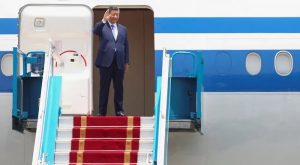(AF) Here we go again on the debt worry and asset bubbles in China. Many have said that China is a “bicycle” economy which will fall down when the economy stops growing at a certain rate – which some have argued is about 5% of real GDP growth.
China’s real GDP growth was 2.3% in 2020, according to its National Bureau of Statistics, but a market consensus for real GDP growth in 2021 is about 8%. The 2.3% GDP growth, achieved through effective control of Covid-19 and without much government stimulus, is still impressive, in our view – if we completely believe this GDP growth is a correct figure. In fact, the reliability of GDP data in China is a can of worms.
In theory, the China story is good news on the start of a global economic recovery. The problem with China is how it has fueled its growth with debt in recent times – not to mention the shadow banking sector which the China Banking and Insurance Regulatory Commission (CBIRC) estimated at 84.8 trillion RMB (US$12.9 trillion) in 2019 or 29% of total banking assets in that year.
Leverage was injected into ineffective and poorly-managed borrowers such as local government financing vehicles (LGFV). In addition, with China growing its urban areas, the demand for residential and commercial properties has risen in tandem with leverage in the property sector, thus concentrating debt within the property sector.
Now comes the core of the China debt problem. We have seen leverage in China being extended because of cheap money rather than borrowers’ repayment capability.
Many market participants in China seem to have gambled that China’s growth music will continue playing and when loan growth continues, non-performing loans may not be as big of problem. We believe the music has stopped at least for now and the Chinese government also seems to have agreed with us.
Credit Infrastructure, Rating Systems Inadequate
China simply does not have proper infrastructure to control credit risk, in our view. Such a system to help control credit risk should include data transparency, disclosure quality, credit rating quality, hedging tools, government support for independent opinions (ie. free press), and a freely-convertible currency (and the renminbi is far from that).
As in any developed debt capital market, investors need to be able to price credits and trade in and out of bonds and loans.
Many foreign investors in RMB-denominated bonds have set up research shops in China to analyse bonds but many investors bought bonds without doing proper homework, in our judgment, and relied solely on Chinese credit ratings, which lack rating granularity.
A lack of liquidity prevents the price of the bonds/loans to be updated regularly and investors simply cannot exit the bonds easily, when necessary.
Picture Chinese borrowers standing on the seashore waist-deep. We now see the water receding from the beach and some of Chinese borrowers can be seen standing naked. The central government has realised the debt problem and has set deleveraging as one of its five major tasks in 2021.
Among many measurements is the so-called “The 3 Red Lines” set for Chinese developers and introduced last August to limit leverage in the property sector.
The 3 Red Lines include: (1) a net gearing ratio of less than 100%; (2) A cash to short-term debt ratio of more than 1x; and (3) a total liability to total asset ratio (excluding advance receipts) of less than 70%.
A breach of any of the three ratios will reflect on the developers’ ability to grow debt from 0% to 15% a year.
In our view, the 3 Red Lines indicate the Chinese government’s lack of trust in the country’s credit research/rating mechanisms. We view the measurement as a forced deleveraging effort on non-investment grade property credits.
We see the minimum cash to short-term debt multiple of more than 1x as especially draconian for non-investment grade credits.
In our view, non-investment grade credits may maintain the multiple below 1x when the borrowers’ unutilised committed credit facilities and/or upcoming sizeable operating cashflow are sufficient to service its short-term debt.
Also, this government enforcement ignores borrowers’ bank relationship in terms of the ability to roll over short-term debt. We expect China’s non-investment grade property developers to boost cash to pay off debt, perhaps through price cutting, short-term debt reduction, equity injection, and a cash conversion cycle reduction.
China Evergrande Group is a classic case on how the 3 Red Lines impacted the firm’s strategy. Evergrande plans to raise $2.1 billion from the sale of a 10% stake in its online home and car sales unit to investors ahead of a planned IPO.
Evergrande also offered discounts to property buyers to raise cash and cut total debt by 10% YoY to 716.5 billion RMB ($109.3 billion) last December. Still, its cash to short-term debt ratio was 0.5x and total debt to capitalisation ratio remains very high at 83% in December (vs 84.6% in 2019).
To put that in perspective, Evergrande’s bonds are rated “B” by S&P but their debt level, in our view, deserves to be in the “CCC” area.
Evergrande’s yield to maturity rose as high as 25% in late September but declined to about 15% for all maturities (EVERRE 23s to 25s), excluding bonds maturing within a year.
Needless to say, the 3 Red Lines are good for Evergrande but management perhaps would not have cut its leverage without a strong word from the Chinese government, in our judgment.
Scrambling for Cash to Cut Debt
Outside the property sector, we also witness Chinese companies scrambling for cash to cut debt.
Suning.com, one of the leading Chinese retails, is planning an IPO for Carrefour China and is reportedly considering selling Inter Milan football club to pay off its debt.
Besides the 3 Red Lines, the Chinese government has made it clear that it will let weak Chinese companies default – a move we applaud.
HNA Group, the Chinese conglomerate, started in an aviation business and expanded aggressively with total debt to capitalisation above 100%. The group grew too fast and became an entity that was very difficult to manage, especially in terms of liquidity.
A series of defaults by HNA subsidiaries led to HNA officially being declared bankrupt in late January.
The group is looking for a debt-to-equity swap from its creditors and equity investors to buy its non-aviation businesses. This story is very common outside China and the fact that the central government finally let HNA default is a positive development for the RMB bond market, in our view.
At the end of the day, these three examples show different perspectives. HNA is rather a legacy and one of the reasons why the Chinese government wanted to clamp down on leverage.
For Evergrande, the group has survived its sky-high leverage all these years on its bank relationship and its extensive land bank, in our view. The 3 Red Lines simply forces Evergrande to behave more responsibly toward its creditors – not to borrow too much and balance its capital structure.
Suning’s potential asset sale is simply to get the company to focus more on its core retail businesses, instead of owning a major Italian football club.
If we were to read the mind of the Chinese government, it perhaps understood better how some of the Chinese non-investment grade borrowers have abused the system and used cheap credit facilities to expand recklessly.
It perhaps understood that the country’s credit research and credit rating infrastructure trails competing debt markets such as Japan, Singapore and the US.
And perhaps, the government understood that it needs a heavy hand to bring reckless borrowers back into line.
We believe this may be nothing more than scolding from the central government to get some borrowers to behave. The scolding may be necessary and most applicable as long as the policy produces the planned results, so everyone can sleep at night.
• Warut Promboon leads Bondcritic’s credit research and consulting practice. Prior to Bondcritic, he led Dagong Hong Kong’s Asian credit rating team, which produces credit research and rating reports across various industries. Prior to Dagong Hong Kong, he was a director of Asian Credit Research at Societe Generale and ING, as well as a Head of ALM Credit Analysis at Standard Chartered Bank. His credit research career spans over 26 years in the US, Hong Kong, Singapore, and Thailand, and includes structured finance, project finance, leverage finance, credit risk management, sell-side credit research, treasury, and rating advisory. His experience spans North America, Europe, and Asia, plus various industries in both financial institutions and corporates.
This report was upgraded on March 3, 2022 to meet new style standards.
ALSO SEE:
- China’s HNA Group goes bankrupt, faces restructuring
- Debt-laden China Evergrande scraps Shenzhen listing plan
- China Evergrande offers 30% off all homes amid debt crisis
- China developers face $53 bn debt tsunami
- Suning sells 23% stake to state-owned investors to strengthen finances
























